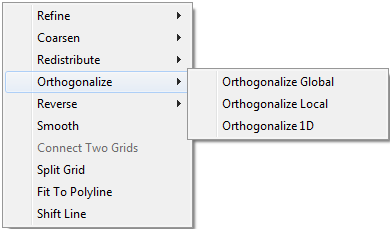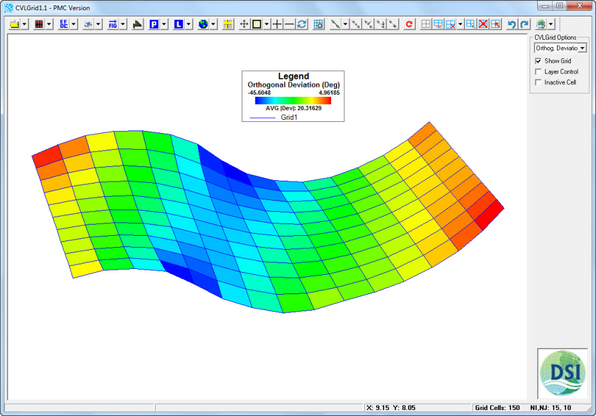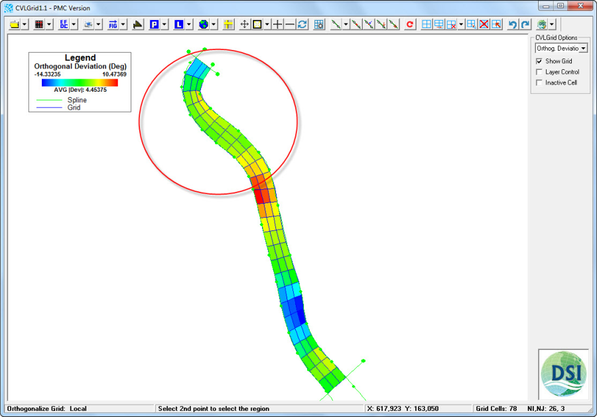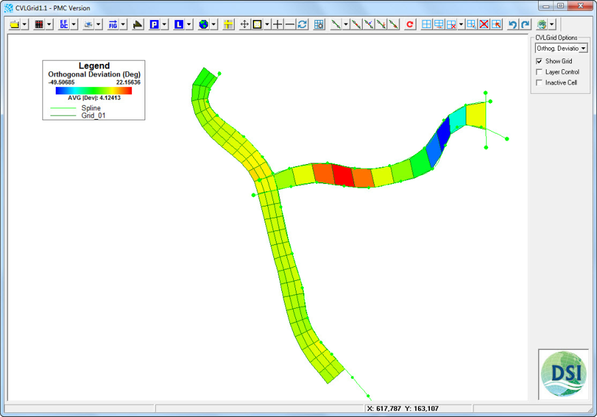The accuracy of a model is increased when the orthogonality of a grid is optimized. A perfect grid would have all cells perpendicular to the boundary lines. This is very difficult to achieve and thus for most EFDC models an orthogonality of under 3o is recommended. The orthogonalization tool is used to reduce the orthogonal deviation of a grid. The parameters of this tool are set in CVLGrid Setting Options described earlier in Section 4 CVLGrid Settings.12 .
The tool has Orthogonalize Global, Orthogonalize Local and Orthogonalize 1D features as shown in Figure 6 221.

| Anchor |
|---|
| _Ref371686225 | _Ref371686225Figure 1 |
|---|
| Figure 1 |
|---|
|
Figure 622 1 Options for orthogonalizing a grid....
The change in grid orthogonality before and after applying Orthogonalize Global are shown in in Figure 6 23 2 and Figure 6 243. It may be seen in the first image that the average orthogonality is 20.3. In the second image, after CVLGrid has automatically reduced the orthogonalization, it is only 2.6.
The change in grid orthogonality before and after applying Orthogonalize Local are shown in in Figure 6 25 4 and Figure 6 265.
The change in grid orthogonality before and after applying Orthogonalize 1D are shown in in Figure 6 27 and Figure 6 287.

| Anchor |
|---|
| _Ref377978224 | _Ref377978224Figure 2 |
|---|
| Figure 2 |
|---|
|
Figure 623 2 Grid image before applying "Orthogonalize Global"

| Anchor |
|---|
| _Ref377978225 | _Ref377978225Figure 3 |
|---|
| Figure 3 |
|---|
|
Figure 624 3 Grid image after applying "Orthogonalize Global"

| Anchor |
|---|
| _Ref432170229 | _Ref432170229Figure 4 |
|---|
| Figure 4 |
|---|
|
Figure 625 4 Grid image before applying "Orthogonalize Local"

| Anchor |
|---|
| _Ref432170230 | _Ref432170230Figure 5 |
|---|
| Figure 5 |
|---|
|
Figure 626 5 Grid image after applying "Orthogonalize Local"

| Anchor |
|---|
| _Ref432170231 | _Ref432170231Figure 6 |
|---|
| Figure 6 |
|---|
|
Figure 627 Grid image before applying "Orthogonalize 1D"

| Anchor |
|---|
| _Ref432170232 | _Ref432170232Figure 7 |
|---|
| Figure 7 |
|---|
|
Figure 628 7 Grid image after applying "Orthogonalize 1D"






